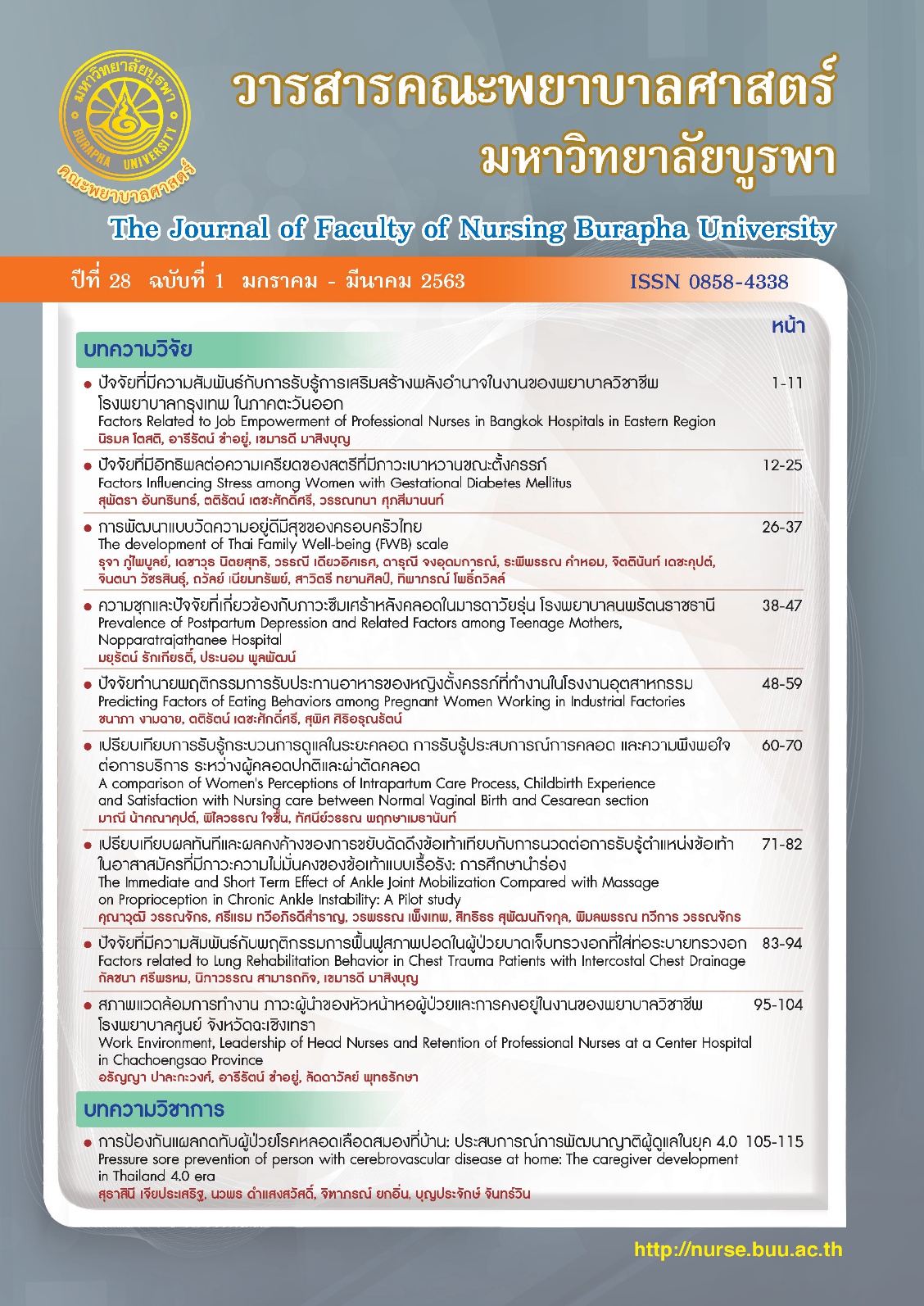ความชุกและปัจจัยที่เกี่ยวข้องกับภาวะซึมเศร้าหลังคลอดในมารดาวัยรุ่น โรงพยาบาลนพรัตนราชธานี
คำสำคัญ:
ความชุก, ปัจจัย, ภาวะซึมเศร้าหลังคลอด, มารดาวัยรุ่น, โรงพยาบาลนพรัตนราชธานีบทคัดย่อ
บทคัดย่อ
การวิจัยนี้มีวัตถุประสงค์เพื่อศึกษาความชุกและปัจจัยที่เกี่ยวข้องกับภาวะซึมเศร้าหลังคลอดในมารดาวัยรุ่น กลุ่มตัวอย่างคือมารดาวัยรุ่นหลังคลอด อายุระหว่าง 14-19 ปี ที่มารับบริการตรวจหลังคลอด 6 สัปดาห์ ที่โรงพยาบาลนพรัตนราชธานี จำนวน 128 คน เครื่องมือที่ใช้ในการศึกษาประกอบด้วยแบบบันทึกข้อมูลส่วนบุคคล ข้อมูลด้านการตั้งครรภ์และการคลอดและข้อมูลด้านจิตสังคม และแบบประเมินภาวะซึมเศร้าหลังคลอด วิเคราะห์ข้อมูลด้วยสถิติพรรณนาหาอัตราความชุกของภาวะซึมเศร้าหลังคลอด วิเคราะห์ความสัมพันธ์ระหว่างปัจจัยส่วนบุคคลและปัจจัยด้านการตั้งครรภ์ โดยใช้สถิติ และ ไค-สแควร์ (Chi – square test)
ผลการวิจัย พบว่า กลุ่มตัวอย่างมารดาวัยรุ่นหลังคลอด 128 คน มีความชุกของภาวะซึมเศร้าหลังคลอด จำนวน 25 คน คิดเป็นร้อยละ 19.5 โดยปัจจัยที่สัมพันธ์กับภาวะซึมเศร้าหลังคลอดในมารดาวัยรุ่นหลังคลอดอย่างมีนัยสำคัญ (p<.05) ได้แก่ การใช้ชีวิตคู่ การไม่ได้วางแผนตั้งครรภ์ อาการเวียนศีรษะ อาการท้องอืด ท้องผูก ผิวคล้ำในขณะตั้งครรภ์ และการมีภาวะซึมเศร้าในการตั้งครรภ์ครั้งก่อน ดังนั้น พยาบาลควรพิจารณาปัจจัยเหล่านี้ในการวางแผนการป้องกันการเกิดภาวะซึมเศร้าในมารดาวัยรุ่น
เอกสารอ้างอิง
Cox, J. L., Holden, J. M., & Sagovsky, R. (1987). Detection of postnatal depression. Development of the 10-item Edinburgh Postnatal Depression Scale. The British Journal of Psychiatry, 150, 782-786. doi:10.1192/bjp.150.6.782
Chaopanitwet, W. (2012). Prevalence and risk factors associated with postpartum depression in BMA General Hospital. Journal of Charoenkrung Pracharak Hospital, 8(1), 12-21. [In Thai]
Kittichotiwat, W. (2018). Prevalence and associated factors of postpartum depression in Kaengkhoi Hospital, Saraburi Province. Journal of the Department of Medical Services, 43(5), 125-130. [In Thai]
Halbreich, U., Karkun, S., (2006). Cross-cultural and social diversity of prevalence of postpartum depression and depressive symptoms. Journal of Affective Disorders, 91(2-3), 97-111.
Hoang, O. T., Deoisres, W., & Suppasemanont, W. (2016). Factors predicting postpartum depression among women in Hai Phong City, Vietnam. Journal of Boromarajonani College of Nursing, Bangkok, 32(1), 92-104. [In Thai]
Lowdermilk, D. L. (2014). Postpartum Complications. In Perry, S. E., Hockenberry, M. J., Lowdermilk, D. L., & Wilson, D. Maternal child nursing care (5th ed.) (pp. 741-50). St. Louis, Missouri: Elsevier.
Nuanchawee, W., Kasiphon, T., & thanasombat, K. (2018). The Prevalence of Postpartum Depression and Factors Predicting Depression in Postpartum Mothers. HCU Academic Journal, 21(42), 65-78. [In Thai]
Nurbaeti, I., Deoisres, W., & Hengudomsub, P. (2018). Postpartum Depression in Indonesian Mothers: Its Changes and Predicting Factors. Pacific Rim International Journal of Nursing Research, 22(2), 93-105.
O'Hara, M. W., & Mc Cabe, J. E. (2013). Postpartum depression: current status and future directions. Annual Review of Clinical Psychology, 9, 379-407.
Panyayong, B. (2013). Postpartum Depression Among Thai Women: A National Survey. Journal of the Medical Association of Thailand, 96(7), 761-767. [In Thai]
Phummanee, N., & Roomruangwong, C. (2015). Postpartum depression teenage mothers: A study at Department of Medical Services, Sirindhorn Hospital, Bangkok. Chulalongkorn Medical Journal, 59(2), 195-205. [In Thai]
Pitanupong, J., & Vacharaporn, K. (2005). Prevalence and predictors of postpartum depression in Songklanagarind Hospital. Songklanagarind Medical Journal, 23(4), 249-254. [In Thai]
Raungjittaveekul, J., & Lalitanantpong, D. (2008). Prevalence of anxiety, depression and social support among postpartum mothers at King Chulalongkorn Memorial Hospital. Chulalongkorn Medical Journal, 52(S), 141–157. [In Thai]
Roomruangwong, C., Tangwongchai, S., & Kuntula, A. (2006). Prevalence of depression in 4-6 weeks postpartum period and related factors among mothers of infants in neonatal intensive care unit, King Chulalongkorn Memorial Hospital. Chula Med, 50(11), 777-787.
Sukasem, N., Ruangphornwisut, R., Sriareporn, P., Siririth, W., & Watcharaprapapong, P. (2016). Predictors of Postpartum Depression. Journal of Nursing and Health Care, 34(1), 47-55. [In Thai]
Withayavanitchai, S. (2010). Prevalence of postpartum depression and associated factors among nursing mothers at King Chulalongkorn Memorial Hospital. (Master’s thesis). Chulalongkorn University, Bangkok. http://cuir.car.chula.ac.th/handle/123456789/36199 [In Thai]
Vacharaporn, K., Pitanupong, J., & Samngsri, N. (2003). Development of The Edinburgh Postnatal Depression Scale Thai version. Journal of Mental Health of Thailand,11(3), 164-9. [In Thai]





